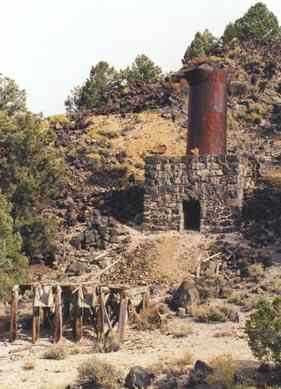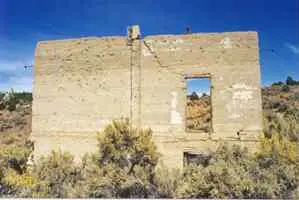AURORA
|
AURORA |
|
|
|
|
NAME: Aurora COUNTY: Mineral ROADS: 4WD Recommended GRID: 4 CLIMATE: Mild Winter, warm summer. BEST TIME TO VISIT: Anytime. |
COMMENTS:
One of the greatest ghost towns
in Nevada although there is not much left to see. Great article from 1947 on Aurora. REMAINS: A few scattered remnants. |
|
Just inside the Nevada border, the biggest problem of this town was deciding just that. For years the town was governed by both California and Nevada until it was finally determined the town was 3 miles inside the Nevada border. Founded in 1860, this town had produced $27 million in Gold by 1869. There were 17 mills with a total of 175 stamps and the population of the town reached 10,000. Aurora became the county seat. At the same time, water was filling the mines faster than they could pump it out, and thus spelled the end of the town. Today there is only rubble left, especially due to the fact that many buildings were dissassembled and the bricks used to make them sold. - Ghosttowns.com Personal Note: Hi. I found your website today while "surfing." I had been looking for information on Aurora, NV with the intent to include it in a trip with my kids. I was devastated to see the pictures of the town, or what is left of it, on your site. When I was 9 years old, in 1954, my dad took the family to Bodie in his new Buick Roadmaster. Bodie was already somewhat known, but not to many. As we drove down the main street of town, my dad told us he would take us to a "real" ghost town that no one knew of. We left Bodie on a treacherous, winding dirt and rock road that went through a narrow canyon, that opened onto a beautiful small town, which was Aurora. I still remember the town of new looking brick buildings, so unusual compared to the weathered wood of other towns, still in perfect condition. There were dishes and flatware on the tables in some of the homes, glass windows were intact, and carriages and wagons were still parked in town. It looked as though the last person out of town had left just minutes before. This was the most pristine little town I have ever seen, and my dad, a ghost town buff and old car collector, told us it wouldn't last for long. I suppose it is naive of me to believe the town would look like it did then, but SHAME on the State of Nevada for letting this gem fall into the condition it is today. Unfortunately, the photos we took that day were lost in a house fire in the 70's. There is nothing there to bring my kids to. SAD! Sincerely, Terry Schauer Aurora's growing pains were often deadly. On February 8, 18 64, more than 200 ore stamps stopped pulverizing ore in the seventeen quartz mills around Aurora. The silence remained unbroken for more than a day until four bodies swung in a gallows constructed by the Aurora Citizens Safety Committee. The committee formed on the day a W. R. Johnson was murdered. Aurora's problem began a year before the murder and had to do with a dispute between two mining companies. Both claimed the same ore ledge from opposite ends. At dawn on February 1, 18 64, W. R. Johnson, and employee of one of the mining companies, was shot to death. The shooters attempted to burn his body in the streets of Aurora. This brought the citizens to action. They formed the Citizens Safety Committee and pursued the capture of the shooters. They were captured and hung on February 8 th without benefit of trial. About a month later the committee disbanded and the rule of law returned to Aurora. Submitted by Henry Chenoweth. I found a reference in a historical society newsletter " Mark Twain described his mining camp experiences in his book Roughing It. The Carson and Aurora stage routed passengers between the camp and Carson City, with connecting lines to Virginia City and San Francisco. It also carried the U.S. Mail and Wells Fargo shipments. The Aurora stage left daily at 7:00 AM and arrived in Carson City in the evening. A trip to San Francisco took 58 hours. Aurora was a busy place and had its share of trouble. The Civil War caused much friction in Aurora, since the townspeople were divided equally in loyalty to the Union or the South. The U.S. Government depended heavily on regular shipments of gold and silver to finance the war effort. In 1863, the Pont Mining Company employed a private security force known as the Daly Gang to protect their claims. The Daly Gang was suspected of being responsible for a series of shootings and other violence. In December 1863, the Pont lost a lawsuit to the Real del Monte Company and had to relinquish all of their claims to them." Real del Monte had extensive holdings in Mexico and the Virgina City area. Operated from the early 1700's until recently: Real del Monte Mining Corp. Announces Notice from Principal Shareholder and Cancellation of Meeting for the Holders of 10% Canadian Convertible Subordinated Debentures Just found your site. Great job! I would like to make on comment though. You will find in the book "Ghosts of the Glory Trail" by Nell Murbarger, a comprehensive history of Aurora. He refers to a trip taken in 1935 to Aurora which describes it as having been one of the best preserved he had seen (but not to the extent the writer describes). But... Your quotation of an individual who claims his father took them there in 1954 is, I think, a victim of a child's imaginative memory. As stated in Murbarger's book it was rumored in 1948 that the owner's of the townsite - the Cain brothers - were going to raze the town for various reasons listed in the book. When Murbarger revisted the town in 1953 he found it had been leveled by the owners.
So, as you can see, it is not likely that the writer saw Aurora intact in 1954. Like Mark Twain said, "The older I get the more I remember that didn't happen".
As an aside, in the brief first foray into your website I did not notice any references to or from "Ghosts of the Glory Trail". If you are not aware of this book it is a gold mine of info on the ghost towns of long ago. It was published in 1956. I and a group of friends used it as a guide in the late 50's to explore the old sites.
Best regards,
John Kruse
 Mill near Aurora Courtesy Dolores Steele  Getting there! Courtesy Dolores Steele
 Aurora Courtesy Dolores Steele
 Aurora Courtesy Dolores Steele
|
|
|---|
|
|